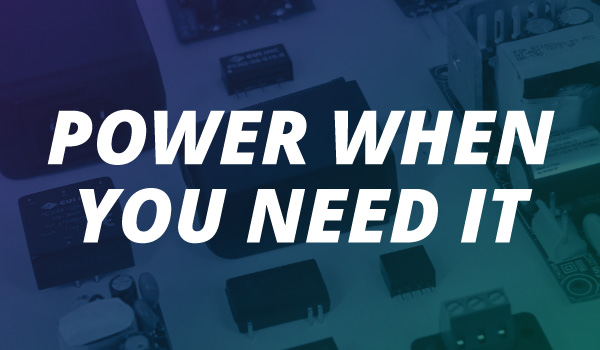POWER SUPPLY SAFETY STANDARDS, AGENCIES, AND MARKS
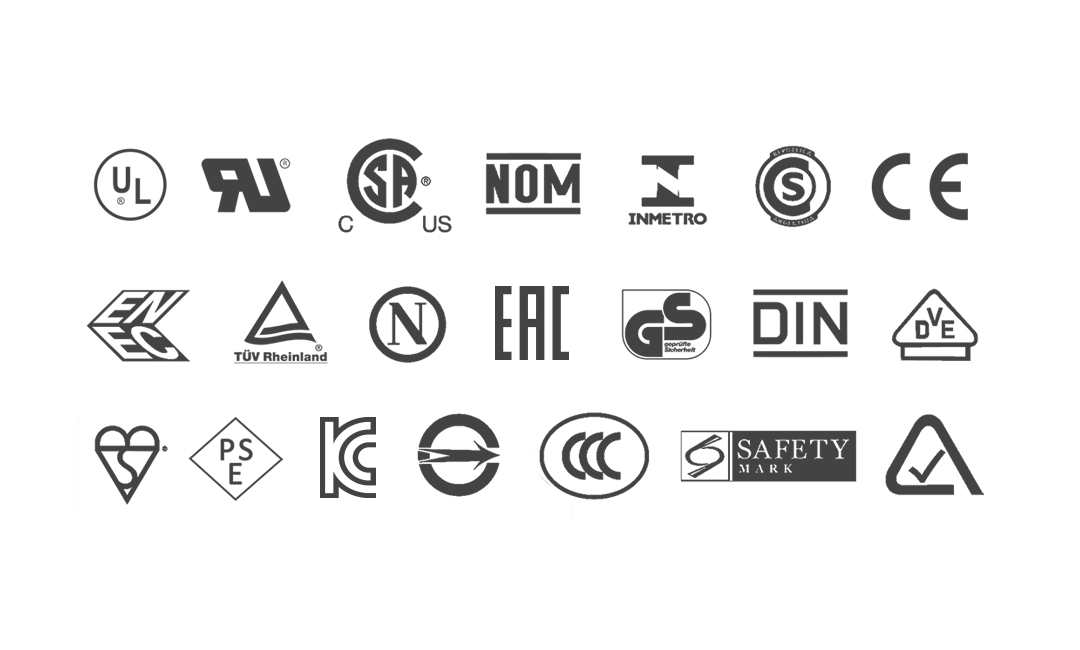
The ability to sell power supplies, either built-in or external types, around the world depends on meeting the relevant safety standards that apply in those territories. These standards are defined and administered by national or international agencies with various government-recognized testing laboratories able to certify compliance with such statutory regulations.
The primary goal of safety standards for power supplies used in electrical equipment is to protect against fire, electric shock and injury. Products meeting these requirements may be identified by a safety mark from the associated standards organization or by a mark indicating compliance with local legislation, within a defined economic area or trading zone.
Understanding the complexities and subtle differences between various standards and marking schemes can be daunting. This application note aims to identify the major standards that relate to power supply safety, the agencies that administer them and/or provide certification, and the marking schemes that can be used to show compliance.
SAFETY STANDARD TERMINOLOGY
Classes of Equipment
Safety standards identify different classes of equipment depending on how their power supplies, especially mains units, isolate secondary circuits and accessible parts from dangerous ac mains voltages:
Class I
Equipment achieves electric shock protection through basic insulation and protective earth grounding. This requires all conductive parts that could assume a hazardous voltage in the event of basic insulation failure to be connected to a protective earth conductor.
Class II
Equipment provides protection using double or reinforced insulation and hence no ground is required.
Class III
Equipment operates from a SELV (Safety Extra Low Voltage) supply circuit, which means it inherently protects against electric shock, as it is impossible for hazardous voltages to be generated within the equipment.
Understanding safety standards and the above classes of equipment requires a clear understanding of circuit definitions, types of insulation and other terminology used in relation to power supplies.
| CIRCUIT DEFINITIONS | |
|---|---|
Hazardous Voltage |
Any voltage exceeding 42.2 Vac peak or 60 Vdc without a limited current circuit. |
Extra-Low Voltage (ELV) |
A voltage in a secondary circuit not exceeding 42.4 Vac peak or 60 Vdc, the circuit being separated from hazardous voltage by at least basic insulation. |
Safety Extra-Low Voltage (SELV) Circuit |
A secondary circuit that cannot reach a hazardous voltage between any two accessible parts or an accessible part and protective earth under normal operation or while experiencing a single fault. In the event of a single fault condition (insulation or component failure) the voltage in accessible parts of SELV circuits shall not exceed 42.4 Vac peak or 60 Vdc for longer than 200 ms. An absolute limit of 71 Vac peak or 120 Vdc must not be exceeded. SELV circuits must be separated from hazardous voltages, e.g. primary circuits, by two levels of protection, which may be double insulation, or basic insulation combined with an earthed conductive barrier. SELV secondaries are considered safe for operator access. Circuits fed by SELV power supply outputs do not require extensive safety testing or creepage and clearance evaluations. |
Limited Current Circuits |
These circuits may be accessible even though voltages are in excess of SELV requirements. A limited current circuit is designed to ensure that under a fault condition, the current that can be drawn is not hazardous. Limits are detailed as follows:
To qualify for limited current status the circuit must also have the same segregation rules as SELV circuits. |
Limited Power Source (LPS) |
These power sources are designed with prescribed output voltage, current, power and short circuit current limits. Specific methods can limit the capacity of the power source. The requirements for wiring and loads supplied by LPS power supplies are relaxed due to the reduced hazard of electric shock or fire caused by an LPS power supply. Power supplies offered as conforming to LPS must have either internal power limiting provisions or external devices limiting current delivered to the load. Internal power limiting can be accomplished by one of three methods:
External devices limiting current delivered to the load can be fuses or circuit breakers. If circuit breakers are employed they must be non-adjustable, non-auto resetting and electromechanical. |
Insulation and Isolation
There are five types of insulation to shield live components with hazardous voltages from other components and circuits as follows:
- Operational / Functional Insulation
Is only necessary for the correct functioning of the equipment and does not provide any protection against electric shock. - Basic Insulation
Insulation applied to live parts to provide basic protection against electric shock. - Supplementary Insulation
Independent insulation applied in addition to basic insulation in order to provide protection against electric shock in the event of a failure of basic insulation. - Double Insulation
Comprising both basic insulation and supplementary insulation. - Reinforced Insulation
Single insulation system applied to live parts which provides a degree of protection against electric shock equivalent to double insulation.
For power supplies, the minimum insulation requirements are:
- Primary to secondary: Reinforced insulation with a minimum dielectric strength of 3000 Vrms.
- Primary to ground: Basic insulation with a minimum dielectric strength of 1500 Vrms.
| OTHER KEY TERMINOLOGY | |
|---|---|
Protective Earth |
Class I equipment must have a protective earth conductor, if insulated it must be a green/yellow or transparent covering. No switch or fuse is allowed. Resistance between earthed parts and the earth termination must not exceed 0.1O, which is tested by a current 1.5 times the current capacity of any hazardous voltage circuit at the point where failure of basic insulation would make the earthed part live. Test voltage maximum is 12 V. Test current may be ac or dc but must not exceed 25 A. |
Clearances (through air) |
Power products are intended for general application and should be designed for worst case conditions (pollution degree 3 and mains voltages up to 264 Vac) for minimum clearances of:
Where formal quality control processes are in place relaxation to 3.4 mm and 1.7 mm is allowed, but reinforced insulation is then subjected to 100% electric strength testing. If an air gap serves as the insulator between a hazardous voltage and the enclosure, the required clearance is 10 mm. |
Creepage Distances |
Tables of creepage distances for basic insulation are given for various pollution conditions and materials, the distances depending on working voltages. These distances are doubled for reinforced insulation. |
Flammability |
The standard requires that the equipment design:
Compliance can be achieved by using V-2 or better rated insulating and printed board materials throughout and ensuring adequate spacing between high temperature components and plastic and painted parts. Use of UL listed materials eliminates the necessity for exhaustive and messy flammability testing. |
Earth Leakage Current |
For Class II equipment this shall not exceed 0.25 mA, for hand held Class I equipment 0.75 mA, and other Class I equipment 3.5 mA. The test for Class II equipment requires conductive metal foil to be attached to an area not exceeding 10 x 20 cm on accessible nonconductive parts and the test is made between this and conductive parts. Tests are carried out at the most unfavorable (highest possible) supply voltage. |
MAJOR SAFETY STANDARDS
The International Electrotechnical Commission (IEC) and the associated International Organization for Standardization (ISO) are the principle agencies responsible for electrical safety standards. Agencies such as Underwriters Laboratories (UL) and Canadian Standards Association (CSA) provide certification in North America, while similar bodies in Europe are Verband der Elektrotechnik (VDE), Technischer Überwachungs-Verein (TUV) and British Standards Institution (BSI). A product meeting an IEC standard such as IEC 60950 or the newer 62368-1 standard may be identified with the standard’s number prefixed instead by UL, CSA or EN (European Norm) to indicate the country where it is certified e.g. UL 60950 or EN 62368-1. Standards like these with the same numbers but different prefixes are sometimes referred to as “harmonized standards”. But while the IEC continues to pursue harmonization, regional differences remain and consequently products intended for multiple markets will need to show all of the required certifications.
IEC 62368-1
Audio/Video, Information and Communication Technology Equipment
The IEC 62368-1 safety standards represent an important transition from the IEC 60065 and 60950-1 standards that currently govern companies marketing audio-visual products or computing/communications equipment in North America and the EU. As the distinctions between AV and ICT equipment become increasingly blurred with new technologies and markets, IEC 62368-1 is a unified replacement for the previous two standards. However, this transition is more significant than a simple merger or name change as IEC 62368-1 adopts fundamentally different engineering principles and terminologies, but like its predecessors, 62368-1 applies to both the end-user as well as to components and subsystems such as power supplies.
IEC 62368-1 ultimately aims to give designers more flexibility in product design and evaluation by implementing Hazard Based Safety Engineering (HBSE) principles that replace the traditional prescriptive approach. These HBSE principles seek to identify potential hazards as energy sources capable of causing pain or injury to others, while finding ways to prevent such energy transfer. This will support the introduction of new and innovative technologies without the standards first needing to be amended, and at the same time minimizing differences between national/regional variations of the standard.
The 2nd edition of IEC 62368-1 is the latest revision that has been accepted by the US, Canada, and EU. This new standard currently coexists with 60950-1 and 60065 to aid designers in the transition and includes several clauses to help companies manage legacy inventory of subsystems and components. However, the official adoption of 62368-1 remains on an uncertain timeline as the EU recently pushed its go live date from June 2019 to December 2020. As a result, UL has also pushed back its adoption timeline to December 2020 to harmonize with the EU. These changing timelines make it imperative for companies to continue to monitor the latest updates and news surrounding 62368-1, while beginning to familiarize themselves with the subtleties and differences between the new and legacy standards. By certifying products to 62368-1 now, companies can further their understanding of the current voluntary standards and avoid the rush to certify their products as the deadline inches closer.
For more information on 62368-1, see our app note
IEC 60950-1
Safety of Information Technology Equipment
IEC 60950-1 consolidates the 2005 2nd edition of this standard with its first and second amendments (from 2009 and 2013 respectively). The standard is applicable to mains, or battery-powered information technology (IT) equipment and office machines with a rated voltage not exceeding 600 V. It is intended to prevent injury and damage to persons and property from such hazards as electric shock, fire, dangerous temperatures and mechanical instability. Note that in Germany this standard is also referenced as DIN EN 60950-1 and as VDE 0805.
IEC 60065
Safety of Audio, Video and Similar Electronic Apparatus
IEC 60065 is intended to protect against fire, electric shock and injury, this time in respect to audio, video and similar equipment, including such examples as video projectors and electronic flash units for photographic purposes. As with the standards already discussed, not all of the protective measures are applicable to power supplies but those that relate to shock and fire require similar precautions with respect to insulation, isolation, limiting voltage and/or current, and measures to increase resistance to fire. IEC 60065 references other standards such as: IEC 60950-1 for SELV voltage limits, TNV (Telecommunication Network Voltages) for equipment that is not connected to the mains and IEC 60695-11-10 for component flammability categories.
IEC 60601-1
Safety of Medical Electrical Equipment
IEC 60601-1, which covers the basic safety and essential performance applicable to medical electrical equipment including surgical, monitoring and hospital devices, has a long history with a number of revisions. The standards follow the same general requirements established in IEC 60950-1, but with increased levels of protection for insulation/isolation, creepage, clearance, and leakage current.
Introduced in 1988, the 2nd edition of IEC 60601-1 focused on safety within a 6-foot radius of the patient known as “patient vicinity” and developed three guidelines of increasing severity. This was followed by the 3rd edition in 2005 which looked at different “means of protection” (MOP) for patients and equipment operators. Edition 3.1, introduced in 2012, made over 500 changes and clarifications to the 3rd edition to address ambiguities arising from evolving medical technology. Most recently, in 2014, the 4th edition of collateral standard IEC 60601-1-2, “Electromagnetic disturbances – Requirements and tests,” was published.
Editions 2, 3, and 3.1
The changes in power supply classification from 2nd edition to 3rd edition dealt with definition, not performance. Both the 2nd and 3rd revisions required two mechanisms for guarding each in the event of a failure. For the area of basic electrical safety and avoiding shock hazard, the 3rd edition further divided means of protection into operator protection and patient protection. This is because the potential hazards seen by each can be quite different; an operator has access to a control panel, for example, while the patient may be “connected” via probes.
Patient leakage currents for various equipment categories were defined in the 2nd edition as follows:
| 2ND EDITION CLASSIFICATION REQUIREMENTS | ||
|---|---|---|
| Type B | Type BF | Type CF |
| Isolation: 1500 Vac | Isolation: 3000 Vac | Isolation: 4000 Vac |
| Creepage: 2.5 mm | Creepage: 5 mm | Creepage: 8 mm |
| Basic Insulation | Double Insulation | Double Insulation |
Instead of these classifications, the 3rd edition required medical device manufacturers to define the classification in terms of “Means of Operator Protection” (MOOP) and “Means of Patient Protection” (MOPP) as determined by an ISO-14971 Risk Analysis / Management process. The table below summarizes these classifications and the type of power supply solution that would be appropriate, depending on whether one or two levels of protection were required.
| 3RD EDITION CLASSIFICATION REQUIREMENTS | ||||
|---|---|---|---|---|
| Classification | Insulation | Isolation | Creepage | Solution |
| One MOOP | Basic | 1500 Vac | 2.5 mm | IEC 60950-1 Rated Power Supply |
| Two MOOP | Double | 3000 Vac | 5.0 mm | IEC 60601-1 Rated Power Supply |
| One MOPP | Basic | 1500 Vac | 4.0 mm | IEC 60601-1 Rated Power Supply |
| Two MOPP | Double | 4000 Vac | 8.0 mm | IEC 60601-1 Rated Power Supply + IEC 60601-1 Rated Dc-Dc Converter |
As mentioned earlier, Edition 3.1 then implemented a number of changes to address issues identified as unclear in the 3rd edition. These changes covered subjects such as essential performance, risk management, mechanical testing, temperature testing, and humidity as well as new specifications for mechanical and electrical hazards.
IEC 60601-1-2: 4th Edition EMC Standards
Due to the growing use of devices like smart phones, laptops, and tablets that communicate wirelessly, the new IEC 60601-1-2 collateral standard was introduced to address a reciprocal concern about electromagnetic compatibility (EMC) affecting both the medical device in question and other devices in the vicinity. In the past, it may have been possible to exclude these sources of interference from sensitive medical environments, such as hospitals, but with more and more medical equipment now intended to operate in the home and other environments, EMC concerns had to be taken into account. These “intended use environments” introduced in the 4th edition are specifically defined in three categories: professional healthcare facilities with attending medical staff such as hospitals, home healthcare defined in collateral standard IEC 60601-1-11, and “special” environments that contain high levels of electromagnetic disturbance (e.g. radio-therapy equipment).
The US, Canada, and member countries of the European Union have officially adopted the new 4th edition EMC standards as of December 31, 2018. However, outside of these major countries adoption of the various revisions of IEC 60601-1 is a mixed picture, with transition to the 4th edition being unclear. This means products shipping internationally may require designs meeting more than one revision of the IEC medical standards or multiple versions of the same design to comply.
For more information on 60601-1, see our app note
IEC 60335
Safety of Electrical/Electronic Household Appliances and Similar Applications
IEC 60335-1 is part 1 of an international standard that covers the safety requirements for devices with rated voltages up to 250 V for single phase and up to 480 V for multi-phase, that are intended for household appliances and similar applications. In addition to the general requirements of part 1, there is a part 2 of the standard which sets additional requirements for some specific device types. Due to the variety of appliances that may be found in a household, over 100 device types have been called out in part 2.
In North America, IEC 60335-1 has been used as the basis for a tri-national standard between the United States (UL 60335-1), Canada (CAN/CSA-C22.2 No. 60335-1), and Mexico (NMX-J-521/1-ANCE). In the US, UL 60335-1, which is in its 6th edition, is harmonized to IEC 60335-1 as part of its participation in the HOUS category of the IECEE CB Scheme. However, the United States does not recognize all of the part 2 standards. The part 2 requirements take precedence over the general requirements laid out in part 1.
The European standard is EN 60335-1 and defines how appliances may comply with European directives, such as the low voltage directive. Unlike the United States, the EU recognizes most, if not all, of the 100+ part 2 standards related to specific products.
IEC 61010-1
Safety of Measurement, Control, and Laboratory Equipment
IEC 61010-1 is another safety standard along similar lines to the above IEC 60950 and IEC 60601 standards, but reflecting requirements in this instance for measurement, control and laboratory equipment, including instruments such as meter and oscilloscopes but also extending to x-ray equipment. Protecting against electrical shock, fire and mechanical or burn injury, IEC 61010 also addresses hazards related to fluids, lasers and UV light as well as those that may arise from the measuring circuit. Not all of these hazards are directly relevant to the equipment’s power supply, but fortunately the latest 3rd edition of the standard separates the general equipment requirements from the more specific measurement circuits, which are now covered by IEC 61010-2.
The 3rd edition also defines more stringent requirements in respect to shock and fire hazards:

Shock
Creepage, clearances, and dielectric values depend on insulation type as well as whether mains or secondary derived from mains.
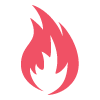
Fire
Voltage for determining limited energy values changed to be more logical. (limited energy means a fire is unlikely)
UL 1310
Safety Requirements for Class 2 Power Units
UL 1310 specifies requirements covering indoor and outdoor use Class 2 power supplies and battery chargers in applications such as lighting systems, machinery and other appliances installed in residential and industrial environments. These units utilize an isolating transformer and other components to provide either ac or dc outputs, subject to a maximum rating of 42.4 Vac peak or 60 Vdc. The standard is aimed at products that primarily power low voltage, electrically operated devices including:
- Portable or semi-permanent direct plug-in units with 15 A blade connections for use on nominal 120 or 240 Vac mains circuits.
- Cord and plug-connected units with a 15 or 20 A plug for 120/240 Vac mains supply.
- Units permanently connected to an input supply nominally of 600 Vac or less.
Direct plug-in and cord-connected units also include dc powered supplies operating from a vehicle battery via a cigarette lighter or equivalent dc connector or from a data port associated with information technology equipment. These units are also limited to a maximum input power of 600 W.
The safety requirements of UL 1310 are defined in terms of:
- Enclosure strength and rigidity to resist likely abuses.
- Built-in over current and over-temperature protection devices.
- A maximum potential of 42.4 Vac peak / 60 Vdc for exposed wires / terminals.
- Protection from “backfeed” voltage.
Other aspects covered by the standard include: packaging, corrosion, switches, weight, dc cabling, mounting, connections, strain relief, operating temperature, humidity and environment (indoor and outdoor).
UL 60079
Explosive Atmospheres
UL 60079 and its IEC and other equivalent standards cover general requirements for the construction, testing and marking of electrical equipment intended for use in explosive atmospheres. Such environments include explosive gas and combustible dust atmospheres (either separately or together). The standard covers the temperatures and pressures under which equipment should be designed to operate safely, taking account of the various potential ignition sources and appropriate protective measures.
MAJOR SAFETY AGENCIES AND PRODUCT CONFORMANCE MARKS WORLDWIDE
The previous section identified many of the national and international bodies that either define regulatory requirements for product safety or provide testing and certification to assure users that the device or equipment complies with the relevant standard(s). Consequently, conformance marking of products to show this compliance is a necessary prerequisite for their sale in most industrialized countries and may be a legal or contractual obligation.
Product marking may simply show compliance with specific standards but increasingly more general marks are used to indicate compliance with all essential or legally imposed safety requirements. CE and UL marks are two of the most widely implemented conformance marks, while there are a number of other safety marks that may be applied in different regions. These are described more fully below. To ease the issue of regional differences, the Certification Body (CB) scheme allows manufacturers who have been issued a CB test certificate by one National Certification Body (NCB) to obtain certification marks from other participating NCBs.

The “Conformité Européenne” or CE Mark
The CE Mark was introduced nearly 30 years ago for certain products sold within the European Economic Area to show conformity with legal requirements in respect of relevant safety, health and environmental directives. The use of the CE logo is a manufacturer’s declaration that the product meets these requirements but the logo may also include a four-digit code identifying the authorized third party (Notified Body) involved in assessing conformance. Simple CE marking is allowed under a self-certification process if the risk level of a product is considered minimal. Where a product is CE marked, it can only carry additional markings if these relate to requirements that do not overlap, conflict or distract from the CE marking. The European Commission’s website provides much more extensive information about CE Marking.

The Underwriters Laboratories or UL Mark
The UL Mark indicates that either Underwriters Laboratories or an equivalent nationally recognized testing laboratory (NRTL) has tested and determined that a product meets UL specified product safety requirements. This certification allows a manufacturer to show that their product is “UL Listed” by using the familiar UL logo. For power supplies this mark would be applied to external units and DIN rail-mount supplies as well as most consumer electronics including computers. Where a supply is considered to be a component part it, along with other electrical components, may be marked with the reversed UR symbol indicating a “UL Recognized” certification. In addition to certifying products to their own safety specifications, UL also offers an assessment process to provide certification to many of the regional safety mark schemes around the world, including those summarized below.
Note also that Underwriters Laboratories of Canada (ULC) is an independent product safety testing, certification and inspection organization, which is accredited by the Standards Council of Canada. It uses the above UL logos accompanied by the letter “C”.

TÜV Rheinland
The TÜV Rheinland Group, headquartered in Cologne, Germany, is a leading provider of technical services worldwide. It is primarily concerned with safety and quality, and operates product testing services that cover Inspection and Certification, with test marks, across a wide range of markets, including electronic components, telecoms and IT equipment.
REGIONAL SAFETY MARKS
Americas, Europe & Asia
The maps in the following section highlight some of the more notable safety marking schemes but is not all-inclusive. In addition, in Europe there are other marks applicable in the Nordic countries and other central and eastern European countries such as Denmark, Switzerland, Hungary, Ukraine and Belarus. In Asia, countries including Hong Kong and India operate their own safety marks.
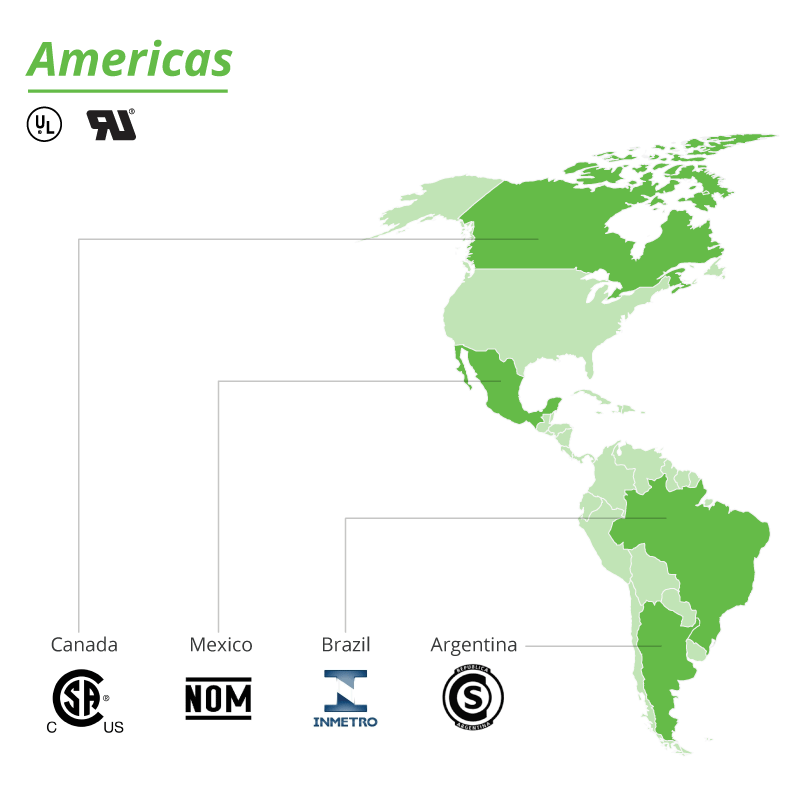

CSA Mark – Canada
The Canadian Standards Association operates the CSA marking scheme alongside UL certification to identify products acceptable in either Canada (C suffix letter) and/or the USA (US suffix).

NOM Mark – Mexico
The NOM Mark identifies compliance with Mexico’s “Normas Oficiales Mexicanas” (NOM) safety standards for household electrical appliances, IT, AV and similar equipment. ANCE is an independent body authorized to grant NOM approval in electric and gas products.

INMETRO Mark – Brazil
Certification of certain product groups, such as medical electrical equipment, ballasts and equipment used in hazardous locations, is mandatory in Brazil with accreditation indicated by the INMETRO Mark. The INMETRO Mark may also be used on a voluntary basis to indicate safety standards compliance for products that are not mandated e.g. IT, audio/visual equipment and home appliances.

S Mark – Argentina
Product certification to IEC-based standards is mandatory in Argentina under the auspices of its standards body IRAM with conformance indicated by the S Mark.
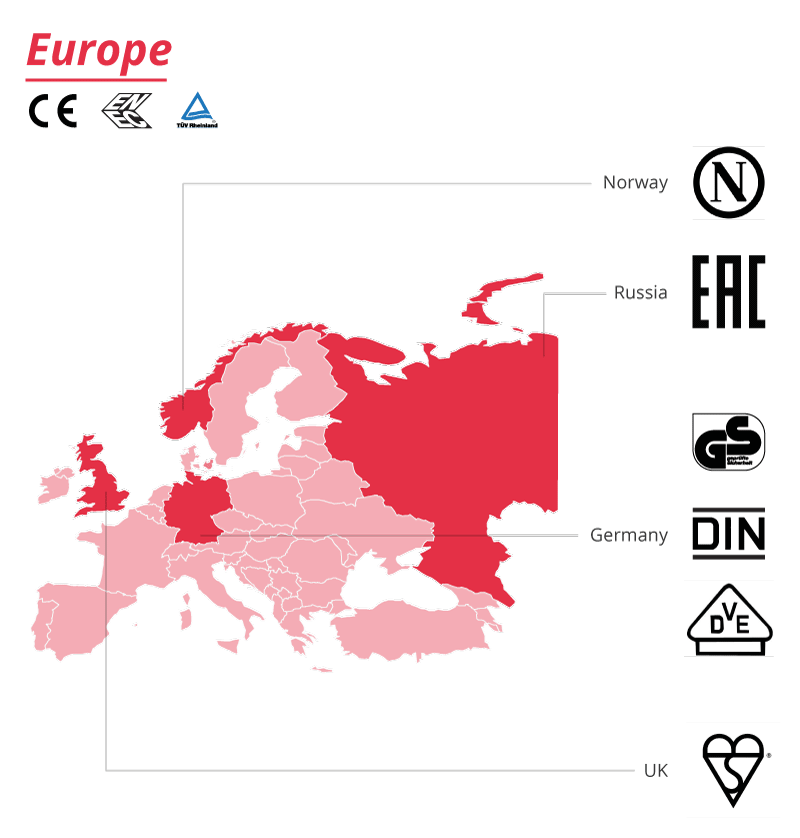

ENEC Mark - Europe
The ENEC Mark is simply the mark used to denote compliance with the European Norm (EN) standards for all electrical product sectors, as tested by approved independent testing laboratories worldwide.

Nemko Mark - Norway
Nemko is an organization similar to TUV or UL that offers product safety testing and certification to worldwide standards. Its direct services cover IT/AV, household and telecoms products but extends to other sectors such as medical equipment, and the oil and gas industry. The mark itself signifies that Nemko has tested or certified the product according to national standards in Norway.

EAC Mark – Russia
The Eurasian Conformity (EAC) mark has replaced the previous GOST-R and PCT national certification standards and marks. This mark is used to indicate products that meet all of the technical requirements of the Eurasian Customs Union.

GS Mark and DIN Mark – Germany/EU
Germany’s TUV standards agency operates the GS Mark (Geprüfte Sicherheit = tested safety) to show conformity with German’s Equipment and Product Safety Act (GPSG = Geräte- und Produktisicherheitgesetz). The GS Mark assures commercial buyers and consumers the product has been tested by an authorized institution such as TUV Rheinland. The DIN Mark is another marking scheme operated by TUV Rheinland certifying component compliance with DIN, EN, IEC and ISO product safety standards.

VDE Mark – Germany
The VDE Testing and Certification Institute is another German-based independent testing organization for electric and electronic products. The VDE Mark indicates conformity with the VDE standards, European or internationally harmonized standards and confirms compliance with protective requirements of the applicable EC Directive(s).

BSI Kitemark - UK
The British Standards Institution (BSI) was the world’s first national standards body and continues to be a leading global standards maker. BSI is also the UK’s National Standards Body, representing UK interests worldwide. The BSI Kitemark is a voluntary certification mark, globally recognized as a symbol of trust, that shows a product or service meets applicable and appropriate British, European, International and other standards for quality, safety, performance and trust.
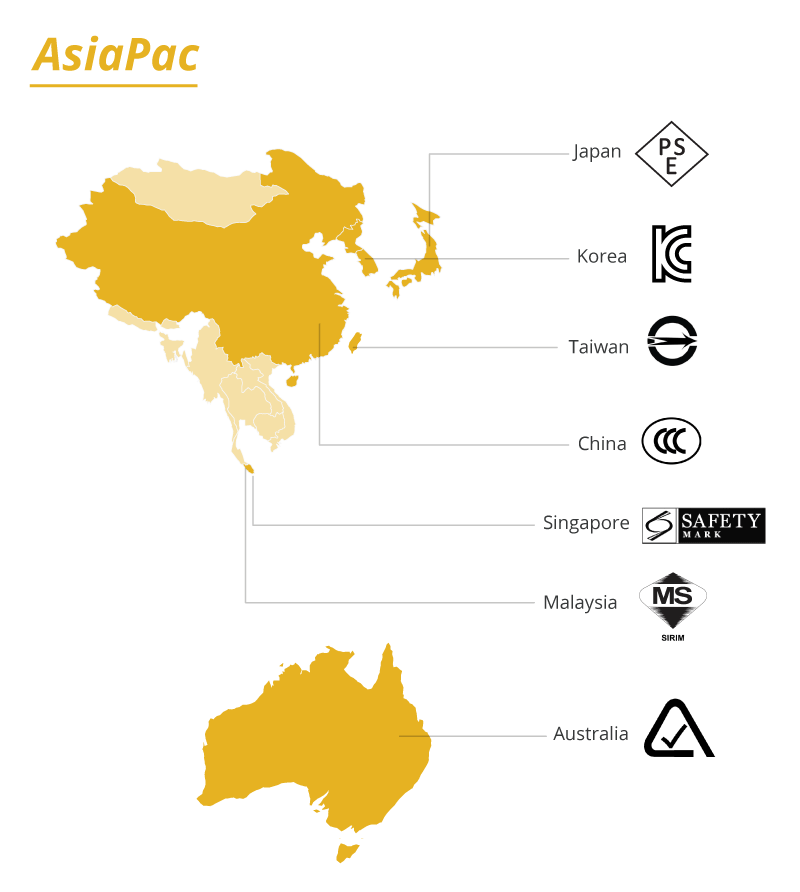

DENAN PSE Mark – Japan
The PSE Mark is used to show compliance with Japan’s Electrical Appliance and Material Safety Law (DENAN) as applied to various classes of product and equipment.

KC Mark – Korea
Korea’s KC Mark is administered by its Agency for Technology and Standards (KATS) to show compliance for mandated products with the Electrical Appliances and Materials Safety Control Law. It replaced the original EK mark.

BSMI Mark – Taiwan
The BSMI (Bureau of Standards, Metrology and Inspection) Certification is the approval scheme for ITE and audio/ video products in Taiwan.

CCC Mark – China
The CCC (China Compulsory Certificate) Mark indicates compliance with Chinese laws and regulations and, as its names implies, is compulsory for any product used for commercial purposes in China.

PSB ‘SAFETY’ Mark – Singapore
Singapore’s safety authority, the Productivity and Standards Board (PSB), requires all controlled goods to be individually marked with the SAFETY Mark.

Suruhanjaya Tenaga (ST) and SIRIM – Malaysia
A statutory body established under the Energy Commission Act 2001, Suruhanjaya Tenaga (ST) is responsible for regulating the energy sector in Peninsular Malaysia and Sabah. ST certification is required for switching power supplies to be imported independently or with a system into Malaysia per the Electricity Supply Act 1990. In addition to getting approval from ST, regulated products must also be tested and certified by SIRIM QAS International where they will receive the SIRIM label.

RCM Tick Mark– Australia
Australia has a national standards body, Standards Australia, covering many different industry sectors including Electrotechnology and Energy, which embraces electrical/electronic equipment and appliances with relevant standards for safety. Australia’s Regulatory Compliance Mark (RCM) now consolidates the previously separate C-Tick, A-Tick and RCM marks, effective from March 2013.
SUMMARY
Despite efforts within Europe, North America and elsewhere to bring about harmonization of safety standards for electrical equipment including power supplies, there are still many different regulations, testing and certification procedures that may need to be taken into account in order to meet legislative requirements in the various territories where such equipment will be sold. Understanding all of these is a challenge and this application note, while it tries to present a fairly comprehensive overview of the various standards, agencies and safety marks, is certainly not a definitive guide.
CUI follows best practices to ensure its power supplies meet the highest levels of safety and performance, offering products approved to standards such as UL, ENEC, TUV and GS while also providing quality solutions that utilize the latest in efficient green power technology.
For more information on regulatory and compliance topics, see our technical papers on EMC Considerations for Switching Power Supplies and Efficiency Standards for External Power Supplies.
